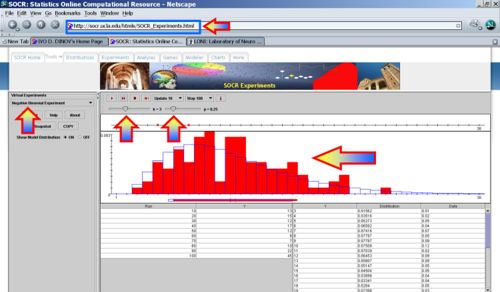SOCR EduMaterials Activities NegativeBinomial
From Socr
(New page: == Negative Binomial Experiment == == Description == The negative binomial experiment consists of performing Bernoulli trials, with probability of success p, until the k'th success occurs...) |
(→Applications) |
||
| Line 22: | Line 22: | ||
== Applications == | == Applications == | ||
| - | [[AP_Statistics_Curriculum_2007_Distrib_Dists | See this Presidential campaigning example]]. | + | [[AP_Statistics_Curriculum_2007_Distrib_Dists#Application | See this Presidential campaigning example]]. |
{{translate|pageName=http://wiki.stat.ucla.edu/socr/index.php?title=SOCR_EduMaterials_Activities_NegativeBinomial}} | {{translate|pageName=http://wiki.stat.ucla.edu/socr/index.php?title=SOCR_EduMaterials_Activities_NegativeBinomial}} | ||
Current revision as of 01:53, 31 January 2008
Contents |
Negative Binomial Experiment
Description
The negative binomial experiment consists of performing Bernoulli trials, with probability of success p, until the k'th success occurs. The successes are shown as red dots in the timeline. The number of trials Y is recorded on each update. The density and moments of Y are also shown in the distribution graph and the distribution table. The parameters k and p can be varied with scroll bars.
Goal
To provide a simulation demonstrating properties of the Negative Binomial(k, p) distribution. This applet also facilitates the calculations of the Negative Binomial mass/density function, the moments and cumulative distribution function. More details about Negative Binomial Distribution are available here.
Experiment
Go to the SOCR Experiments and select the Negative Binomial Experiment from the drop-down list of experiments on the top left. The image below shows the initial view of this experiment:

When pressing the play button, one trial will be executed and recorded in the distribution table below. The fast forward button symbolizes the nth number of trials to be executed each time. The stop button ceases any activity and is helpful when the experimenter chooses “continuous,” indicating an infinite number of events. The fourth button will reset the entire experiment, deleting all previous information and data collected. The “update” scroll indicates nth number of trials (1, 10, 100, or 1000) performed when selecting the fast forward button and the “stop” scroll indicates the maximum number of trials in the experiment.
The parameters k and p may be varied according to the user and their values will affect the spread and center of the graph of the mass function.
Note that the empirical density and moments graph begin to converge to the distribution graph after every trial. In other words, the empirical graph is more saturated at the left side of the graph because the distribution graph obtains maximum values on this side. The spread of the empirical graph is rather large but most of the values are towards the left with outliers on the right.
Applications
See this Presidential campaigning example.
Translate this page:
